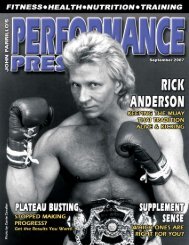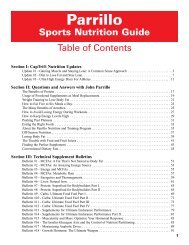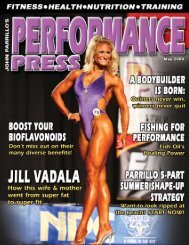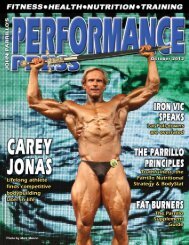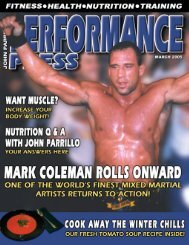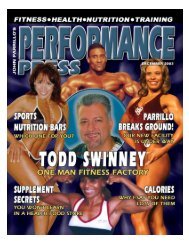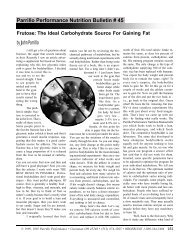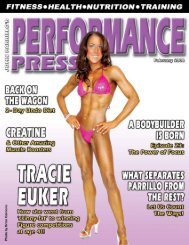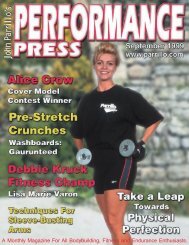A Monthly Magazine For All Bodybuilding, Fitness And - Parrillo ...
A Monthly Magazine For All Bodybuilding, Fitness And - Parrillo ...
A Monthly Magazine For All Bodybuilding, Fitness And - Parrillo ...
Create successful ePaper yourself
Turn your PDF publications into a flip-book with our unique Google optimized e-Paper software.
TEN COMMON TRAINING MISTAKES<br />
crime lies through their teeth as they<br />
say, “it was all you, bro!” Obviously,<br />
since it takes the partner 5-minutes to<br />
recover from his spot, that’s an untruth.<br />
Watch the training partner’s eyeballs<br />
bulge, teeth grit and the carotid artery<br />
swell from the exertion. Even on your<br />
heaviest sets, a spotter should provide<br />
only enough assistance for you to complete<br />
the final rep or two, and then<br />
barely enough to allow you to finish<br />
the rep. If you can do more than 2-3<br />
forced reps, something is wrong. Lift it<br />
yourself and your gains will soar. Plus,<br />
you’re training partners will appreciate<br />
it!<br />
5. Fast Rep Speed<br />
Some trainers seem to think that each<br />
set is a race to see how fast they can<br />
pump out reps. Erroneously assuming<br />
that a rapid-fire tempo is superior for<br />
building muscle. Nothing could be further<br />
from the truth. Fast reps are not<br />
only dangerous, since they tend to<br />
place undue stress on the joints and<br />
connective tissues, but not nearly as<br />
effective as slow, controlled reps. I like<br />
the old Nautilus guideline that dictated:<br />
“two seconds up, four seconds<br />
down.” This emphasized the eccentric,<br />
or negative component of the repetition.<br />
I further recommend taking a onesecond<br />
count at the point of full contraction<br />
and squeeze the muscle hard.<br />
That’s a real rep, one that you’ll feel<br />
deep in the muscle tissue.<br />
6. Repeating Routines and Exercises<br />
over and over<br />
Our bodies adapt quickly to various<br />
forms of exercise-induced stress. This<br />
is particularly true of weight training.<br />
Would you do the same exercises in the<br />
same sequence at the same pace, over<br />
and over? If you stay with any routine<br />
for more than a month or two your body<br />
will no longer respond. Why should<br />
it? The body is incredibly adaptable<br />
and once it adapts, progress comes to<br />
a halt. Make a conscious effort to infuse<br />
variety into your workouts. There<br />
is such a wide array of equipment, exercises,<br />
training techniques and routines<br />
that there is no excuse for getting stuck<br />
in a rut for any length of time. Keep<br />
your muscles guessing and they will<br />
have no choice but to keep on adapting<br />
and growing.<br />
7. Overtraining<br />
John <strong>Parrillo</strong> has repeatedly stated that<br />
there is “no such thing as overtraining,<br />
only under-eating” (and under-sleeping).<br />
There are, however, examples of<br />
what can only be classified as overdoing<br />
it. Some people train every single<br />
day for one, two, three or four hours.<br />
You shouldn’t need more than 45 to 90<br />
minutes to train per session and at very<br />
least take one full day off every week.<br />
If you’re feeling tired and run down or<br />
have lost your appetite and no longer<br />
look forward to going to the gym, odds<br />
are you’re overtraining. Cut back on<br />
your volume and/or you training frequency.<br />
Also, look at your supplements<br />
to see if you are meeting the considerable<br />
nutritional needs of a hard-training<br />
bodybuilder. We bodybuilders require<br />
quite a bit more of certain key nutrients<br />
(like protein and carbohydrates) than the<br />
average person and if you train hard and<br />
do hard cardio you will need a lot of<br />
clean calories to recover.<br />
8. Not Warming Up<br />
Warming up is important. Not only does<br />
it get the blood flowing and the body<br />
temperature up, but also warming up a<br />
muscle about to be weight trained, completely<br />
and thoroughly, prevents injuries.<br />
I recommend that at least five minutes<br />
of cardiovascular exercise precede<br />
any weight training. A warm muscle is<br />
more elastic and pliable and far less susceptible<br />
to tears and rips than a cold<br />
and stiff muscle. Take your time and do<br />
several warm-up sets, gradually increasing<br />
the weight each succeeding set before<br />
tackling the big numbers. Most torn<br />
muscles can be traced to either insufficient<br />
warm ups, or no warm ups at all. A<br />
few extra minutes spent warming up is a<br />
small price to pay and a great injury insurance<br />
policy. Anyone who has ever<br />
been injured by rushing to a top set will<br />
tell you that emphatically.<br />
9. Avoiding Tough Exercises<br />
While exercises like side laterals, leg<br />
extensions, curls and the pec deck certainly<br />
have an important place in your<br />
training regimen, tougher movements<br />
like overhead pressing, squats, and<br />
bench presses should always take priority.<br />
Too many trainers get caught up<br />
in workouts that consist entirely of easy<br />
isolation exercises. While they may<br />
work to failure and achieve a phenomenal<br />
pump, such workouts will not deliver<br />
the massive size and raw strength<br />
that bodybuilders crave. Be sure that<br />
every bodypart gets at least three or<br />
four sets per workout of a heavy, basic<br />
compound exercise before delving into<br />
the easier stuff. By avoiding the tougher<br />
exercises you are cheating yourself and<br />
foregoing muscle gains. <strong>And</strong> don’t lift<br />
weights my grandmother could crush<br />
(see #2).<br />
10. Lack of Preparation<br />
Great workouts don’t just happen by<br />
accident. People cannot expect to just<br />
pop into the gym at any given moment<br />
and have a kick-ass training session.<br />
Usually, upon arrival, they flounder<br />
around for awhile, then, after finally<br />
starting, moan about how they are inexplicably<br />
experiencing a lousy workout.<br />
A little preparation will prevent<br />
this. (See my recent article, “The Five<br />
P’s” for more on this topic) Get plenty<br />
of sleep the night before. Be sure to<br />
eat plenty of complex carbohydrates an<br />
hour or two before training. Take your<br />
supplements at the proper times. Finally,<br />
have a good idea of exactly what<br />
you’ll be doing that day before you<br />
even step foot in the gym. People who<br />
take the time to visualize and mentally<br />
rehearse their workouts ahead of time<br />
almost always have more productive<br />
training sessions than those who do<br />
not. Take a clue from this and plan it<br />
out ahead of time!<br />
Info-Line: 513•531•1311 John <strong>Parrillo</strong>’s Performance Press • March 2000 25



